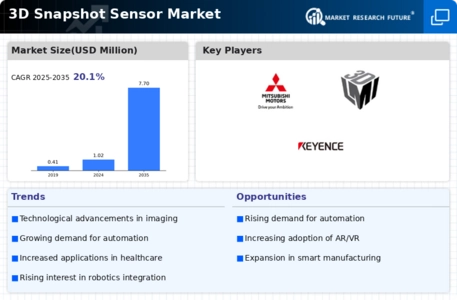Market Analysis
In-depth Analysis of 3D Snapshot Sensor Market Industry Landscape
The market dynamics of the 3D snapshot sensor market are shaped by a combination of factors that influence its growth, trends, and overall trajectory. One of the primary dynamics is technological advancements. The continuous evolution of sensor technologies, including improvements in resolution, accuracy, and speed, drives the market forward. As new innovations emerge, the capabilities of 3D snapshot sensors expand, enabling a wider range of applications across various industries.
Consumer demand is a significant driver of market dynamics. The increasing adoption of 3D sensing technologies in consumer electronics, such as smartphones and gaming devices, contributes to the market's growth. Consumers seek enhanced features like facial recognition, augmented reality, and gesture control, prompting manufacturers to integrate advanced 3D snapshot sensors into their products. This demand, in turn, fuels the development and innovation within the market.
The competitive landscape is another crucial aspect of market dynamics. The presence of multiple players competing for market share fosters innovation and drives companies to differentiate their products. Strategic collaborations, mergers, and acquisitions are common as companies seek to strengthen their positions and expand their capabilities. The competitive dynamics also impact pricing strategies, with companies vying to offer cost-effective solutions to attract a larger customer base.
Regulatory factors play a role in shaping the market dynamics of the 3D snapshot sensor market. Compliance with data privacy, security regulations, and quality standards is essential for market players to ensure the acceptance and adoption of their products. Changes in regulations can impact product development and market entry strategies, influencing the overall market dynamics.
Global economic conditions contribute to the ebb and flow of the 3D snapshot sensor market. Economic growth or downturns can influence consumer purchasing power and corporate investments in technology. In times of economic expansion, there is typically an increased capacity for businesses and consumers to invest in innovative technologies, fostering market growth. Conversely, economic uncertainties may lead to a temporary slowdown in market dynamics as stakeholders reassess their spending priorities.
Emerging trends also shape the market dynamics of 3D snapshot sensors. The increasing interest in applications like autonomous vehicles, robotics, and virtual reality drives the demand for advanced sensing technologies. Market dynamics are influenced by these trends as companies strive to align their product offerings with the evolving needs of industries and consumers.
Environmental considerations have become increasingly relevant in market dynamics. Sustainability and energy efficiency are gaining importance, leading to the development of eco-friendly 3D snapshot sensor solutions. Companies that prioritize environmentally conscious practices may attract environmentally-aware consumers and gain a competitive advantage in the market.
Market dynamics are also impacted by societal factors. Changing preferences, lifestyles, and cultural shifts influence the demand for specific applications of 3D snapshot sensors. For instance, the growing interest in smart homes, smart cities, and healthcare applications contributes to the market dynamics as companies adapt their products to meet these emerging needs.
Investor sentiment and funding activities play a role in market dynamics as well. Positive industry outlook, successful product launches, and strategic partnerships can attract investments, further fueling research and development efforts and market expansion. Conversely, negative sentiment or uncertainties may lead to cautious investor behavior, affecting the pace of innovation and market dynamics.






Leave a Comment